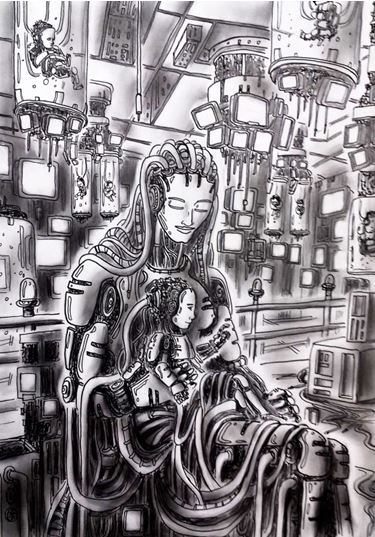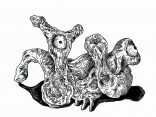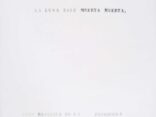Autore
Indice
Abstract
A Wound on Poetry: a Reading of Pasolini’s Teorema Through analyzing
Pasolini’s Teorema, the intention of the paper is to suggest that besides a sublimated effervescence that, according to Durkheim, blends people together, there is also another force that does not let itself be sublimated and for this reason checkmates the Symbolic order of society. This force is the death drive, namely the drive that, according to Freud, is beyond the pleasure principle and works against the flourishing of the individual inside society.
È soprattutto quando è lieta e innocente che la vita non ha pietà.
Pier Paolo Pasolini
- Community
“Community” comes from the Latin word communitas, which is composed of cum that means “with” and munus, a word that has three meanings: “duty”, “debit”, “gift”[1]. As Marcel Mauss showed in his Essai sur le don[2], a gift is never free, but instead imposes a servitude that can be avoided only by reciprocating the gift. Communitas therefore – although with different nuances – means being tied to something to which we are obliged, something that demands a credit from us. Indeed, every form of community requires people to give up some of their time, energy, and freedom in order to join the group.
Why do people choose to submit to this obligation, why do they renounce their sovereignty in order to be part of a community? Taking into account the Aristotelian notion of ζῷον πολιτικόν but enriching it with an ethnographical investigation, Durkheim[3] states that humans need to belong to a group; far from simply being the result of social conformity, is the founding moment of every human society. In analyzing aboriginal societies (that according to Durkheim are the most archaic form of societies), he explains that when people do something together (for instance, when they manage to kill an animal that will allow them to survive), a tremendous joy takes possession of them and they start to act in an unusual way while sharing this powerful feeling. Durkheim calls this joy effervescence and describes it as an overwhelming force that blend people together in a common feeling of belonging. In this way, he shows that unconscious forces working beyond reason push people together before they sign the rational agreement that we call society. According to Durkheim, the Symbolic order that bears every form of society is the result of the sublimation of this original force that he called effervescence.
Through analyzing Teorema – a 1968 movie in which Pasolini describes the story of a typical bourgeois family that encounters an obscure and unintelligible figure who, in having sex with each member of the family, destroys the Symbolic order of the house – I want to suggest that besides a sublimated effervescence that blends people together, there is also another force that does not let itself be sublimated and for this reason checkmates the Symbolic order itself. This force is the death drive, namely the drive that, according to Freud[4], is beyond the pleasure principle and works against the flourishing of the individual inside society.
- Teorema
Since the very beginning of the movie we are thrown into the middle of this stereotypical family’s lives in which everyone acts out their role without questioning it. There is no dark side in their actions or their words, no gap; it is as though everyone conforms perfectly to what society expects from him or her. As if they were living in an opaque dream where everything is perfectly orderly and understandable, they live up to their role, without questioning it.
This scenario is made possible by a careful study of photography. In painting their life, Pasolini uses a limited range of dull colors that is replaced only after the arrival of the new strange figure who illuminates the scene in an iridescence of bright colors. This change of colors is not used only to show the irremediable nature of the stranger’s passing, but also to suggest to the audience the importance Pasolini places on images instead of words. From the arrival of the guest, we enter into the depths of the unconscious where rational thought is no longer in charge. Here images express what words cannot.
Choosing to value images over dialogue can be traced back to two different semiotic registers that are bound together. The first register is psychoanalytic and allows us to read the arrival of the queer[5] figure as the arrival of the death drive or, to use a Lacanian word, of the Real that breaks the Symbolic order; the second register is related to Pasolini’s larger artistic project of making films like poems. Since 1965, Pasolini has sought to realize what he called Il cinema di poesia[6] – a cinema of poetry – that consists of making movies whose images have a higher semantic value than words, where images can express what words are not able to grasp. This is why Pasolini chose to create a movie without a real history, or more precisely, a movie where the plot is nothing but a placeholder to say something that is irreducible to the plot itself. Far away from being a diachronic history, Teorema is in fact a theoretical essay of images by which Pasolini shows how sexuality is inherently destructive of a Symbolic order that seeks to sublimate it.
In trying to show the collapse of the Symbolic order caused by the appearance of the Real, Pasolini imagines an encounter with the unbearable threat to the subject from which the subject itself is born – a threat that people usually try to escape through society, religion, love and all the other forms of sublimation. In fact, Teorema reminds us that while we can certainly try to ignore the negativity inseparable from our existence, that only last up to the time of the appearance of the strange guest on the doorstep. The arrival of the guest is in fact not really an arrival but an appearance: it has always been there, but now that we see it, nothing will be the same. When the Pater Familias, the foundation and the backbone of the Symbolic order[7], comprehends the undoing of his own figure, and especially, feels the enjoyment coming from this loss of sovereignty, he is only able to say to the guest: «Tu sei dunque venuto in questa casa per distruggere»[8]. And this is exactly what the Real does: open the abyss of the unconscious destroying our fantasy of sovereignty, our faith in the power of consciousness.
In an attempt to glimpse and understand the queer figure of the guest, many critics have assigned to it a fixed identity, but from my point of view it is an error to attempt to entrap it in a stable concept, an error that misses its structural function. As Lacan and queer theory show, there is no stable name for something that is outside of language, there is no concept for something that is out of the signifying chain of the Symbolic. The guest is not an object and not even a man or a woman, although sometimes it takes the shape of either; it is rather a placeholder used to say something that is unspeakable, something that, although it is perceived with extreme vividness, escapes our rational understanding. As a matter of fact, the guest could be anything that, in its irresistible seduction, checkmates the claims of sovereignty of our consciousness, anything that in showing to the subject his constitutive division, makes it impossible for him to continue to live and think as he did before, anything that, thanks to its unbearable and relentless force, is able to change the priorities of our existence. Therefore, if it has a shape, it is the shape of an irresistible desire, or to be more accurate, the shape of what Lacan calls jouissance[9].
In describing this peculiar function, we can resort to a term that belongs to the Catholic tradition but use it for its etymological meaning: the diabolic. The etymology of “diabolic” is in fact exactly the opposite of Symbolic. Both terms come from the Ancient Greek but if the word symbol (synballein) is composed by syn = together, and ballo = put, so “put together”, then diabolic (diaballein) is composed of dia = division, and ballo = put, which means to separate, to undertake a path that no one knows where it leads to. The guest in fact has the power of enacting the negativity that undoes our sovereignty and in doing so separates us from a stable identity that doesn’t reckon the incoherencies that characterize us as human beings.
So finally, the only thing that we can do if we want to “picture” – or envision – the guest, is to try to imagine something of an indefinable richness, something that, instead of calming our desire to understand, undermines our categories of understanding. Is this not what our sexual drives do? Threaten our certainties when these are firmer? Destabilize us when we feel peaceful and safe? And, moreover, is this not how we are politically and ethically driven when we embody what has been called “queer”?
It is therefore clear what Pasolini meant when he wrote that Teorema is not a realistic story but an «emblematic and enigmatic medical report»[10]. Indeed, if we try to reduce Teorema to the three Aristotelian unities of action, time, and place, if we try to fathom it with rational thought, if we try to penetrate the Real with the categories of the Symbolic (categories that are always already checkmated by the Real itself) we arrive only at waste matter, a lifeless corpse. Teorema comes to life if we follow Pasolini in this descent into the depths of the Real, if we put aside the categories we use to understand the world – categories we also use to protect us from the world – and we let ourselves become overwhelmed by the image, in the same way that the protagonists of the film have been overwhelmed by the Real of their sexual drives.
- The Postman
I conclude by focusing on a particularity that has been ignored, or worse, lambasted by critics: the character of the postman played by Ninetto Davoli. Actually, the postman has really nothing to do with the development of the movie but, as I would like to suggest, his presence is the most significant of the entire movie. As I have tried to demonstrate, Pasolini creates a poem in which images are able to let us feel what negativity is and how drives can overwhelm our consciousness, but in creating this sort of flawless poem on negativity, Pasolini is not able to resist his own negativity, his own drives, and therefore jeopardizes his work in giving a role to his friend Ninetto. What the critics have said about the “pointless” character of Ninetto Davoli is difficult to reject but what escapes them is the very meaning of this accidental/incidental character: beside the host that we have all seen clearly, there is another host who instead of revealing the hidden desire of the protagonists, reveals Pasolini's desire. Ninetto Davoli, and not Terence Stamp – the useless postman and not the beautiful actor who plays the Visitor – is the real guest, the relentless drive that, instead of erupting from the movie, erupts from Pasolini himself to reveal his structural and unbearable negativity.
Walter Benjamin claimed that in every work that is a real work of art there is «something that can never be reduced to silence, and that insistently calls on us the name of the person who lived there, who is still real there, and who will never entirely be absorbed into art»[11]. And this is exactly what Pasolini does when, driven by his passion for Ninetto, created a “pointless” character. What gives the work of Pasolini its artistic “status” is not its formal perfection, but the weakness by which Pasolini yields to his drives, the weakness by which he is able to scar his own movie with a unique artistic gesture. It is when he yields to his passions and in doing so signs his work with his irreducible existence that his movie becomes a poem and he realizes what he calls the Cinema of Poetry.
[1] R. Esposito, Communitas. Origine e destino della comunità (1998), Einaudi, Torino 2006.
[2] M. Mauss, Essai sur le don. Forme et raison de l'échange dans les sociétés archaïques (1923-24), PUF, Paris 1973.
[3] E. Durkheim, Les formes élémentaires de la vie religieuse: le système totémique en Australie (1912), PUF, Paris 2013.
[4] S. Freud, Jenseits des Lustprinzips (1920), Reclam Verlag, Leipzig 2013.
[5] I use the term queer referring it to the famous American literary theory called “queer theory”.
[6] P.P. Pasolini, Il «cinema di poesia» (1965), in Empirismo eretico, Garzanti, Milano 2012.
[7] “La realtà del padre potente e immortale”, as it is defined in the novelistic version of Teorema: P.P. Pasolini, Teorema, (1968), Garzanti, Milano 2014, p. 69. Italic in the original.
[8] Ibid., p. 104.
[9] The concept of jouissance is expressed with different nuances in many of Lacan’s seminars. I am referring here in particular to J. Lacan, Le séminaire. Livre XIX. Ou pire…, Seuil, Paris 2011.
[10] «Come il lettore si è già certamente accorto, il nostro, più che un racconto, è quello che nelle scienze si chiama “referto”: esso è dunque molto informativo; perciò, tecnicamente, il suo aspetto, più che quello del “messaggio”, è quello del “codice”. Inoltre esso non è realistico, ma è al contrario, emblematico… enigmatico… così che ogni notizia preliminare sull’identità dei personaggi, ha un valore puramente indicativo: serve alla concretezza, non alla sostanza delle cose», P.P. Pasolini, Teorema, cit., p. 18.
[11] W. Benjamin, Kleine Geschichte der Photographie (1931), in Gesammelte Schriften, Suhrkamp, Frankfurt am Main 1977. Translation mine.








